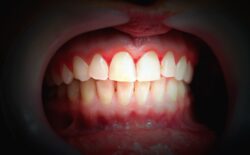About half of all adults in the United States will suffer from gum disease, an infection affecting the gum tissue, at some point in their lifetimes. Though prevalent, not many people can recognize the symptoms of this disease.
In fact, sometimes, gum disease will not present with visible symptoms at all. This is why you should attend regular check-ups at your dentist’s office for routine periodontal disease screenings that can identify this infection promptly. The sooner you can diagnose this problem, the quicker you can begin treating it.
The disease is easier to treat when found quickly. And it will not go away without intervention from your dentist. You can better seek the dental attention you need if you know more about potential signs of gum disease. Read on to learn details about four symptoms that you might notice if you contract gum disease.

Inflamed Gum Tissue
The early stage of gum disease is gingivitis. When oral bacteria infect the gum tissue at this initial phase, the bacteria eat away at the gums, which can result in irritation and inflammation. You might notice swelling, redness, soreness, and bleeding when this occurs.
Sometimes, the gums can become irritated for acute reasons, like brushing your teeth too hard or getting food stuck in your teeth. But if the symptoms persist and become chronic, then you should consult with a dentist about the potential of periodontal disease.
Gum Recession
As gum disease advances and deteriorates more of the gum tissue, the gums will begin to change even further. Swelling in the gums will evolve into a recession of the gum tissue. You might see more of the surface of your teeth exposed when the gum tissue weakens.
Not only will this result in changes in the appearance of your gums, but it might also lead to oral discomfort including tooth sensitivity. Changes in the way your smile looks can point to a progression of this infection that warrants attention from your dentist.
Changes in Dental Alignment
Advanced gum disease will result in damage to the teeth and jawbone as well as the gums. With deterioration happening on multiple fronts when it comes to your smile, you will notice that your teeth will change.
Without proper support from the connective gum tissue, the teeth might start to shift their alignment and become crooked. You might see the teeth begin to overlap one another or form gaps between them.
The teeth might also start to seem loose and wobbly in their sockets. Without treatment for gum disease, the issue will worsen, and you might face tooth loss. So do not ignore this concern.
Chronic Bad Breath
Bad-smelling breath might develop after eating certain strong foods. But the effect should go away when you complete your oral hygiene routine. If you develop chronic bad breath, also known as halitosis, you might suffer from gum disease.
This happens when bacterial build-up within the gum pockets due to the infection produces a foul odor that impacts your breath. Tell your dentist if you have bad breath that lingers and has no clear cause.
